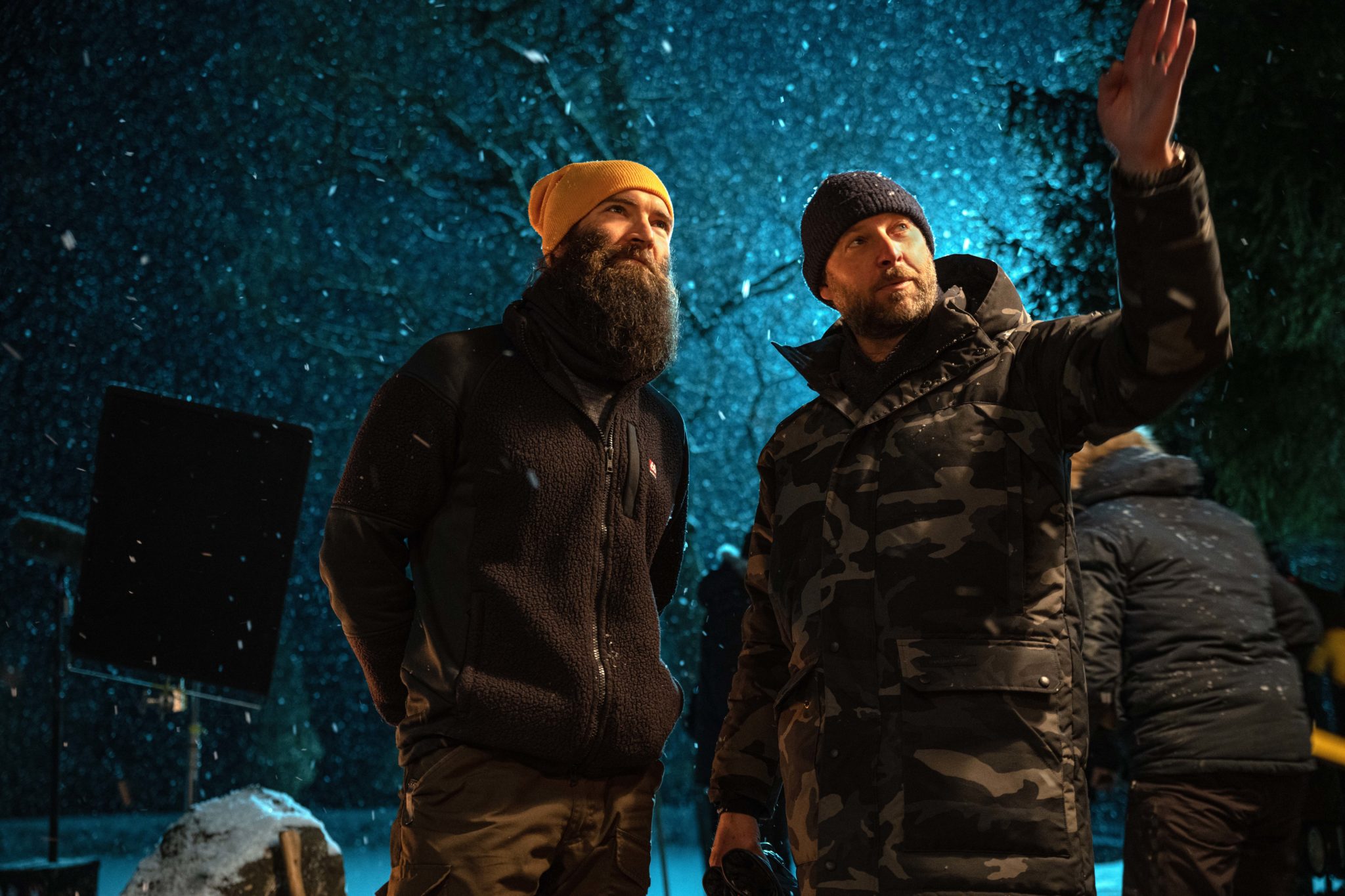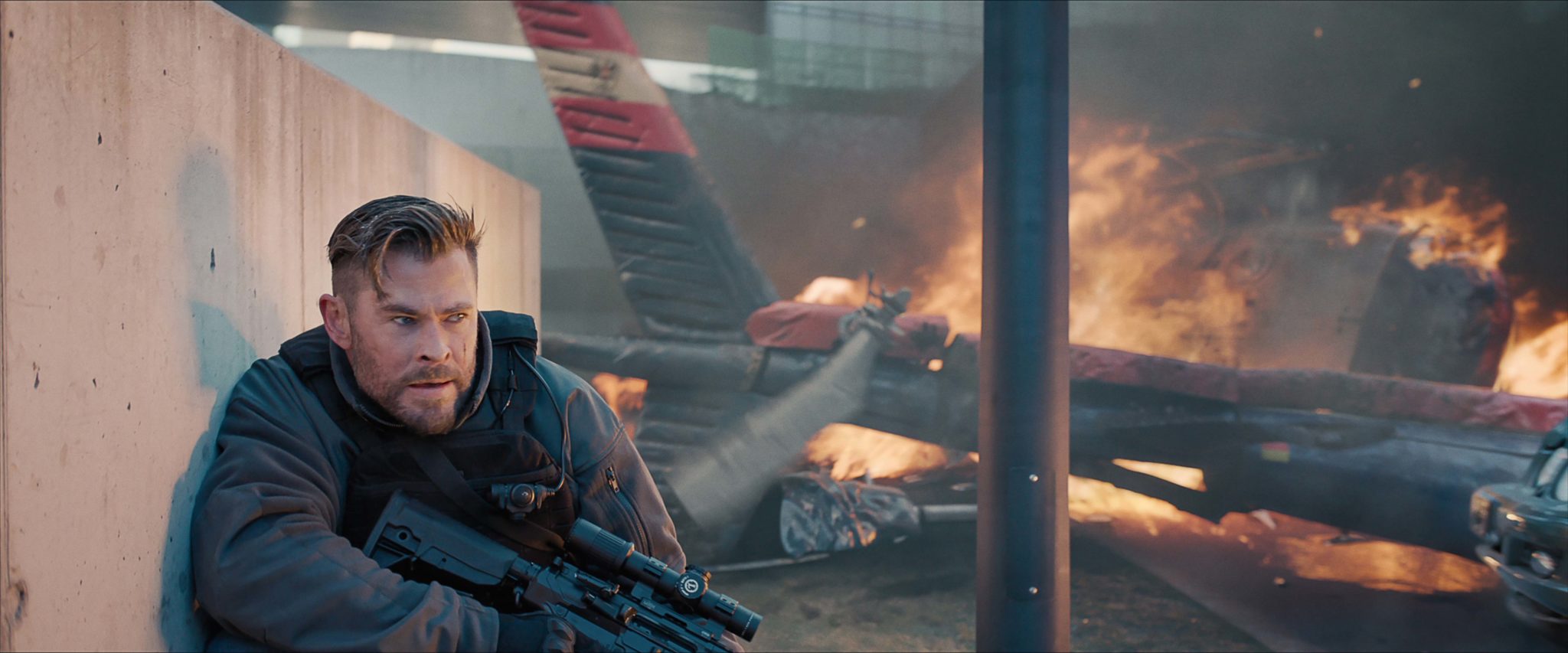- Film And TV
- 25 Jul 23

Having been presented with a top secret dossier, Paul Nolan agrees to meet director Sam Hargrave, to discuss his exhilarating action sequel Extraction 2.
With the first installment having received a hugely positive response upon its release during lockdown in 2020, Extraction 2 impressively raises the bar in the action stakes. Chris Hemsworth returns as Australian special forces agent Tyler Rake, who this time has to rescue the sister (Tinatin Dalakishvili) and two kids of his ex-wife Mia (Olga Kurylenko), who are imprisoned by gangsters at Tkachiri prison in Georgia.
It’s a rip-roaring affair that scarcely lets up the breakneck pace throughout. When I catch up with American director Sam Hargrave in Berlin – who returns from the first outing along with writer Joe Russo – he notes that the enthusiastic fan reaction to Extraction meant a sequel was immediately on the cards.
“Seeing the audience response to the first movie, we as filmmakers went, ‘Let’s keep this character moving’,” he reflects. “It took a bit to tease out the story, because we hadn’t been planning on it when we made the first one. But there were were a lot of ideas floating around as soon as the spark was lit. It was like, ‘We might want him alive still’, so ideas started to fly.
“Actually, the first seed of an idea came from Joe saying, ‘If we do a second movie, I think it’d be cool to have Tyler Rake extracting someone from a prison in one major sequence.’ It’s crazy that one of the first ideas I heard actually survived and made it into the final product.”
The sequence in question is quite possibly the action scene of the year, a bravura 20-minute effort that follows Tyler breaking Mia and the kids out of prison, culminating in a stand-off atop a speeding train. Even thinking about the complexity of shooting it is enough to make you want to lie down.
Advertisement
“If you’re gonna scale the level of difficulty, that’s an 11!” laughs Sam. “You’re trying to one-up the first movie. I know after doing that, Chris said, ‘I’m never doing one of those again.’ Then we’re doing a second movie, and I’m going, ‘Hey Chris, we’re going to do another oner and it’s gonna be twice as long.’ He’s like, ‘You gotta be kidding me!’ But he was game.
“The technical challenges were immense. Taking that prison sequence in particular, there are 400 action performers on camera. We also had dozens and dozens of behind-the-scenes people, who were working constantly to make it happen, all at the same time. You’ve got costume working with all these background performers, stunts, hair and make up, special effects…
“Most of the time it was snowing for real, but maybe when it lulled, you had to have special effects put in some snow. Also, you’ve got the lights moving around in every shot, and camera and sound. Trying to make sure everyone’s in the right place at the right time was extremely challenging. We rehearsed the whole thing over the course of four or five months, and then it took 29 days to shoot that 21-minute sequence.”

(L-R) Director Sam Hargrave and cinematographer Greg Baldi on the set of Extraction 2. Cr. Jasin Boland/Netflix © 2023
As well as creating an especially memorable action sequence, this time around, Hargrave and co. also wanted to dive into Tyler’s back story.
“That’s correct,” nods the director. “After the first movie, when we touched on the emotional core of what makes Tyler tick, we thought it would be very interesting to expand on that. We wanted to put onscreen a lot of the things that we as filmmakers talked about for the first movie. There was back story stuff that we didn’t have the space for, so we tried to make sure that we allowed audiences to peer more deeply in to Tyler’s past.
Advertisement
“We wanted to make him a little more vulnerable and confront him with different characters who expose things about his past, and make him deal with things emotionally. It wasn’t about just putting a bunch of physical objects in his path.”
In terms of the influences on Extraction 2, the gun-play has echoes of John Wick, while the kinetic action recalls Sly Stallone’s heyday in Rambo.
“For sure,” acknowledges Hargrave. “I grew up watching Rambo, Die Hard, True Lies – that era of American action movies. Hong Kong cinema was also very influential on me, so you’re talking about the movies of Jackie Chan, Jet Li and Sammo Hung. I believe the Wick universe was also heavily influenced by Hong Kong cinema and that style.
“You’ve got a similar background there, in terms of the point of view on action, how to photograph it, and the beauty of the action choreography. Those were definitely strong influences for me too.”
Interestingly, Tyler Rake is a quieter, more internal character, as opposed to the wisecracking style of John McClane, as so unforgettably portrayed by Bruce Willis in the Die Hard series.

Chris Hemsworth as Tyler Rake in Extraction 2. © 2023 Netflix, Inc.
Advertisement
“Tyler Rake is maybe relatable to audiences in a different yet similar way to McClane,” muses Hargrave. “McClane is a little louder, but that’s his character – he’s a New York cop. Whereas Tyler Rake is a former Australian SAS guy, who’s built these walls around him and is very closed off, based on his past choices. He had to run away from his son, so there’s a lot of guilt and shame around this character.
“I think they’re fundamentally different in that way, but relatable, in that we’ve all made decisions that we feel guilt or shame around. So you have this character who does these amazing things, but his inner life is also very tumultuous. To peel back the curtain on that and say, ‘He’s not just this perfect guy kicking butt’, that can be very relatable to audiences.
“And yet, we give him the opportunity to make a different choice, and I think that can be inspiring to people as well.”
Laid up in hospital after the events of the first movie, in which he had to rescue an Indian drug lord’s son in Bangladesh, Tyler is presented with his new mission by the mysterious Alcott, played by The Wire and Luther star Idris Elba. In-time honoured fashion, Alcott presents Rake with a dossier on the bad guys – a scenario which I don’t think has ever not worked in a movie.
“Yeah, it’s a pretty classic set up!” says Sam. “‘Here’s the problem, go solve it.’ But going back to Idris, the reason he’s such a great choice for this is that he brings out something unique in Tyler Rake as a character. There’s real onscreen chemistry between Idris and Chris – they’re friends and they go way back into the Marvel universe. It’s actually hilarious, because they’ve both got such great voices.
“When they’re onscreen together, it becomes this voice-off – who has the lower, gravelly voice? As you go through the day, each person’s voice gets lower! They’re voices are incredible, it’s so much fun to watch.”
Like John Wick director Chad Stahelski, Hargrave’s background is in stunt direction, with his credits including work on blockbuster franchises Avengers and The Hunger Games. Was it always his ambition to finally sit in the director’s chair?
Advertisement
“It was,” he says. “I started out wanting to be Jackie Chan, that was my goal in life – I was gonna be the white Jackie Chan. He was the stuntman, actor, writer, director, editor: he does it all. So that was how I was gonna approach movies, and I still kind of do, because I’ve done most of those things.
“It was always my path, but the storytelling aspect of being a director is very intriguing and inspiring to me. The job of collaborating with many different types of people and creative minds to achieve a common goal is uniquely challenging and rewarding.”

(L-R) Chris Hemsworth as Tyler Rake and Tinatin Dalakishvili as Ketevan in Extraction 2. Cr. Jasin Boland/Netflix © 2023
It does seem as if stunt direction lends itself particularly well to helming action movies.
“It’s interesting,” says Hargrave. “I don’t necessarily think that because you’re a stunt performer, you’re gonna be a good director. It’s not a direct correlation. The people who’ve done it successfully have not only been successful at stunts, they also have the mindset of a filmmaker and storyteller. That’s a pre-requisite and the most important aspect. Coming from a stunt background, you do definitely have a distinct point of view, in that you can tell the story through action.
“I’ve had to bring my own unique perspective to my films. Because you can give 10 directors the same action sequence, and they’ll do it 10 different ways, and each one would probably be super entertaining. So I’m trying to focus on the point of view I can bring – how can I show an audience my version of an action sequence, which hopefully is unique and entertaining at the same time?”
Advertisement
When you’re overseeing a sequence as complex as the 20-minute action scene in Extraction 2, it must get incredibly stressful and frustrating.
“It really does,” says Sam. “Making an action movie is a very difficult, gruelling thing. You definitely have to have the constitution for it, because it could tear you up if you let it. The most important thing is surrounding yourself with a great team you know and trust, who can make the process fun. Because at the end of the day, I grew up loving these movies. So to have the opportunity to make something like this and entertain audiences is a dream come true.
“Yes, it’s extremely challenging and difficult, but you have to take a step back at times and remember how fortunate you are to be sitting in the director’s chair. You have all these people willing to work with you to create your vision – it’s a really wild space to be in. I’m super fortunate and thankful every day that I have this opportunity.”
In addition, movies still allow the opportunity to create that kind of action spectacle, as opposed to the more limited confines of TV.
“For sure,” says Hargrave. “It’s coming more to TV, with the rise of streamers and the money going into them. TV’s getting pretty impressive, but I still think what people crave out of movies, especially these tentpole action movies, is spectacle. Otherwise, you kind of fade into the background. There are so many wild action movies to compete with, that to stand out, you have to do something unique and memorable.”
• Extraction 2 is streaming on Netflix now.










